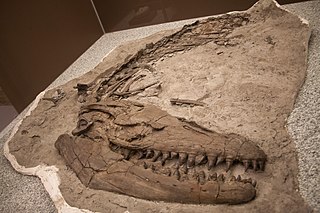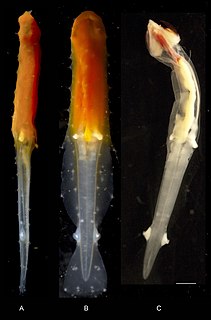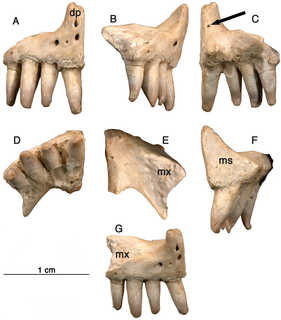Related Research Articles

The Chaetognatha or chaetognaths are a phylum of predatory marine worms that are a major component of plankton worldwide. Commonly known as arrow worms, about 20% of the known Chaetognatha species are benthic, and can attach to algae and rocks. They are found in all marine waters, from surface tropical waters and shallow tide pools to the deep sea and polar regions. Most chaetognaths are transparent and are torpedo shaped, but some deep-sea species are orange. They range in size from 2 to 120 millimetres.

Amiskwia is a genus of large, soft-bodied animals known from fossils of the Middle Cambrian Lagerstätten both in the Burgess shale formation in British Columbia and the Maotianshan shales of Yunnan Province, China. It is interpreted as a member of the Gnathiferan total group.

Mycterosaurus is an extinct genus of synapsids belonging to the family Varanopidae. It is classified in the varanopid subfamily Mycterosaurinae. Mycterosaurus is the most primitive member of its family, existing from 290.1 to 272.5 MYA, known to Texas and Oklahoma. It lacks some features that its advanced relatives have.

Prognathodon is an extinct genus of marine lizard belonging to the mosasaur family. It is classified as part of the Mosasaurinae subfamily, alongside genera like Mosasaurus and Clidastes. Prognathodon has been recovered from deposits ranging in age from the Campanian to the Maastrichtian in the Middle East, Europe, New Zealand, and North America.

Pliosaurus is an extinct genus of thalassophonean pliosaurid known from the Kimmeridgian and Tithonian stages of Europe and South America. Their diet would have included fish, cephalopods, and marine reptiles. This genus has contained many species in the past but recent reviews found only six to be valid, while the validity of two additional species awaits a petition to the ICZN. Pliosaurus currently consists of the type species P. brachydeirus, and also P. brachyspondylus, P. carpenteri, P. funkei, P. kevani, P. macromerus, P. rossicus and P. westburyensis, as well as the invalid P. portentificus. Most species of Pliosaurus are notable for their large body size, while the others, P. brachydeirus, P. brachyspondylus and P. portentificus, are known exclusively from immature individuals. Species of this genus are differentiated from other pliosaurids based on seven autapomorphies, including teeth that are triangular in cross section.

Captorhinus is an extinct genus of captorhinid reptiles that lived during the Permian period. Its remains are known from Oklahoma, Texas, Europe, India, the Pedra de Fogo Formation, Parnaíba Basin, Brazil and the Madumabisa Mudstone, Zambia.

Plesiotylosaurus, meaning "near Tylosaurus", is an extinct genus of marine lizard belonging to the mosasaur family. It is classified as part of the Mosasaurinae subfamily, alongside genera like Mosasaurus and Prognathodon. The genus contains one species, Plesiotylosaurus crassidens, recovered from deposits of Middle Maastrichtian age in the Moreno Formation in California.
Baldwinonus is an extinct genus of basal synapsids from the Early Permian. The type species is Baldwinonus trux, named in 1940 from the Cutler Formation of New Mexico. A second species, Baldwinonus dunkardensis, was named in 1952 from Ohio. Baldwinonus was first classified in the family Eothyrididae, but the group has since been recognized as a wastebasket taxon for many early synapsids. More recently, Baldwinonus has been placed in the family Ophiacodontidae. Its phylogenetic relationship to other early synapsids remains poorly understood because it is only known from a few fragments of bone.
Gnathifera is a clade of generally small spiralians characterized by complex jaws made of chitin. It comprises the phyla Gnathostomulida, Rotifera, Micrognathozoa, and Chaetognatha. It may also include the Cycliophora.
Hirudo orientalis is a species of medicinal leech. It has been confused with Hirudo medicinalis, but has recently been recognized as a different species. This Asian species is associated with mountainous areas in the subboreal eremial zone and occurs in Azerbaijan, Iran, Uzbekistan and Kazakhstan. It occurs also in Georgia, and probably in Armenia.

Heterokrohniidae is a family of sagittoideans in the order Phragmophora.
Spadellidae is a family of sagittoideans in the order Phragmophora. Spadellidae prey on plankton and commonly reside in the epipelagic zone of the ocean.

Archeterokrohnia is a genus of chaetognaths in the family Heterokrohniidae.The total body length excluding tail fin 28.5; the tail section is 55.2% of the tail fin; head blunt when hooded, triangular after preservation, head with 3.5 mm. Furthermore, the eyes are absent, the trunk section is orange throughout in life, and the organism exists around 3200 m below sea level.
Heterokrohnia is a genus of chaetognaths in the family Heterokrohniidae.
Xenokrohnia is a genus of chaetognaths in the family Heterokrohniidae. It consists of one species, Xenokrohnia sorbei Casanova, 1993, which lives in a marine environment. The initial discovery was made from six specimens found in a deep-sea search in the Bay of Biscay for Spadella equidentata Casanova, 1987. A uniquely large (ventral) secretory gland, separate from other chaetognaths, defined the new genus and species. The gland, which is likely used to rid the body of digestive fluids, is probably due to the unique feeding habits of the species; these may include scavenging habits. The presence of an unusual and seemingly superfluous digestive utility is similar to Archeterokrohnia palpifera Casanova, 1986, which have a larger pair of pedipalps then what is common for chaetognaths.
Bathyspadella is a genus of chaetognaths in the family Spadellidae. The genus shares morphological similarities to Eukrohniidae and Spadellidae, although it is molecularly similar to Heterokrohniidae. The unusual position of Bathyspadella would indicate a need to revise the existing order of Phragmophora; however, that would be very difficult, as a number of genera and species exist only in small or difficult to access populations, by which it would be difficult to fully examine all related species. A review of the Chaetognatha, published after the discovery of B. oxydentata, found that the standard division of Phragmophora and Aphragmophora to be improper molecularly, noting the close morphological convergence of the Krohnittidae (Aphragmophora) and Xenokrohnia.
Calispadella is a genus of chaetognaths in the family Spadellidae. It consists of one species, Calispadella alata Casanova & Moreau, 2005. It is differentiated from other species of Spadellidae by the presence of an unusually long tail segment and a rare aspect of the lateral fins, similar to that of Paraspadella gotoi Casanova, 1990. The species is noted by the complete development of seminal vesicles in juveniles and the use of lateral fins for buoyancy in the deep-sea waters where the specimens were found. It was the first to be described exclusively in the range of deep-sea hydrothermic vents.
Paraspadella is a genus of chaetognaths in the family Spadellidae. Paraspadella was originally considered as Spadella before a revision separated that genus into three genera: Spadella, Paraspadella, and Gephyrospadella, the last of which is now synonymised to Paraspadella. The initial division was based on previous knowledge of three groups of Spadella, in a similar manner in which Sagitta was divided into a family of genera. Paraspadella is differentiated from Spadella by the presence of disparate (digital) adhesive organs, present in the former to various degrees, but entirely absent in the latter.

Arisierpeton is an extinct genus of synapsids from the Early Permian Garber Formation of Richards Spur, Oklahoma. It contains a single species, Arisierpeton simplex.
References
- 1 2 3 Casanova, J. (1996). A new genus and species of deep benthic chaetognath from the Atlantic: a probable link between the families Heterokrohniidae and Spadellidae. Journal of Natural History, 30, 1239–1245.
- ↑ Bone, Q. & Pulsford, A. (1984). The sense organs and ventral ganglion of Sagitta (Chaetognatha). Acta Zoologica, 65(4), 209–220.
| | This Chaetognatha-related article is a stub. You can help Wikipedia by expanding it. |